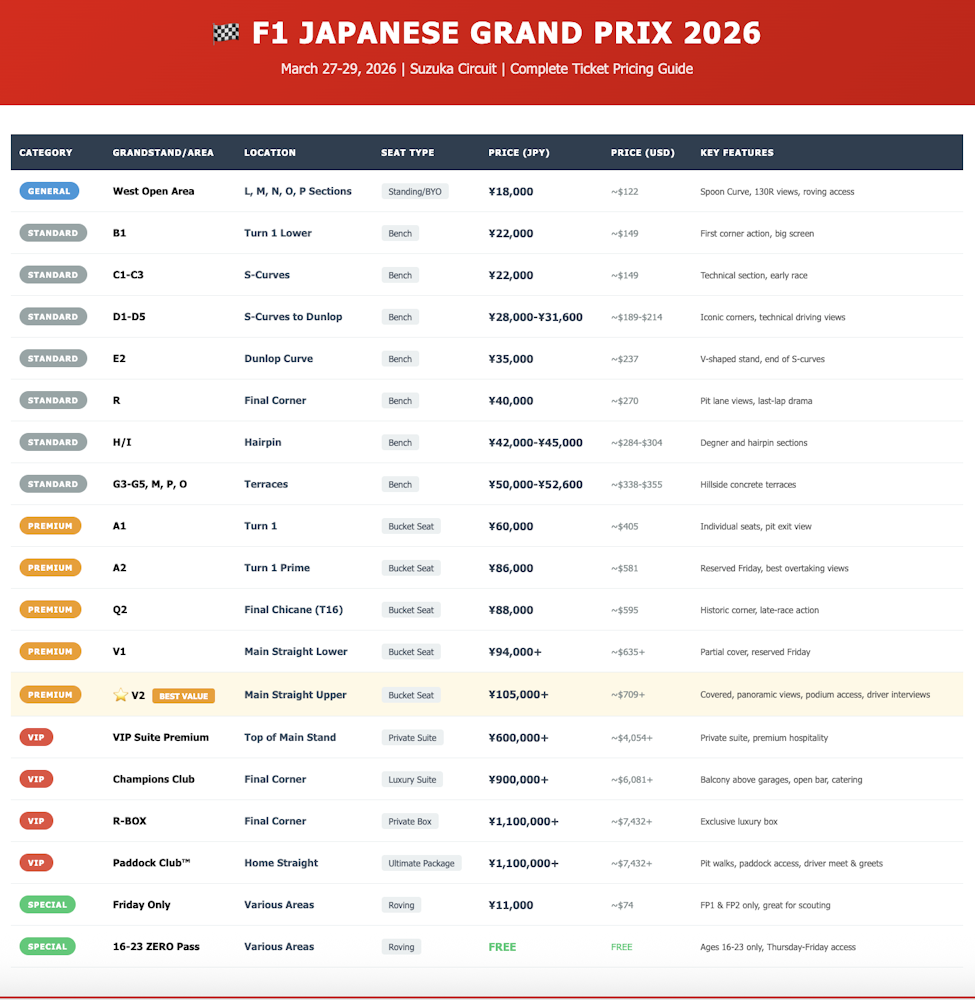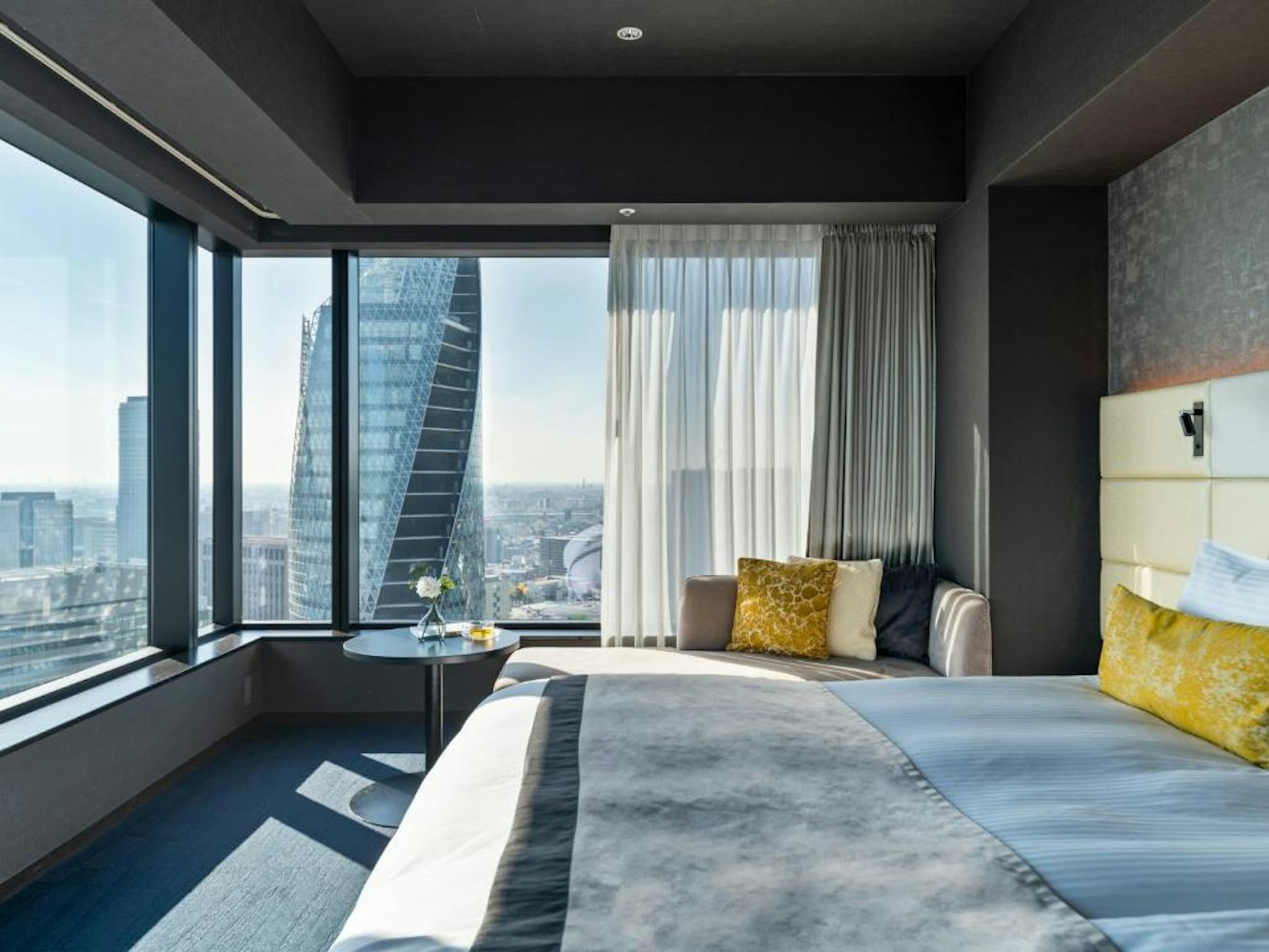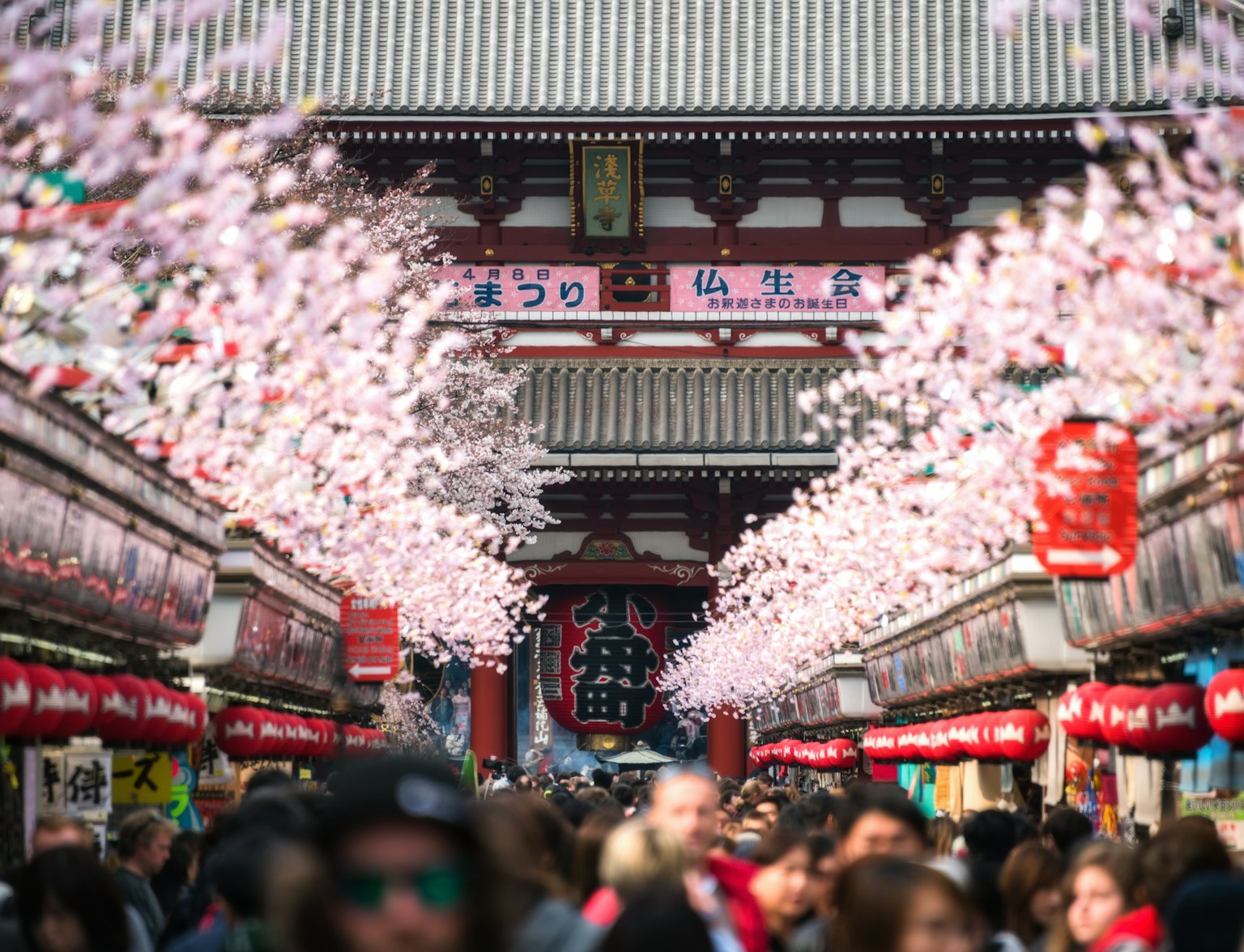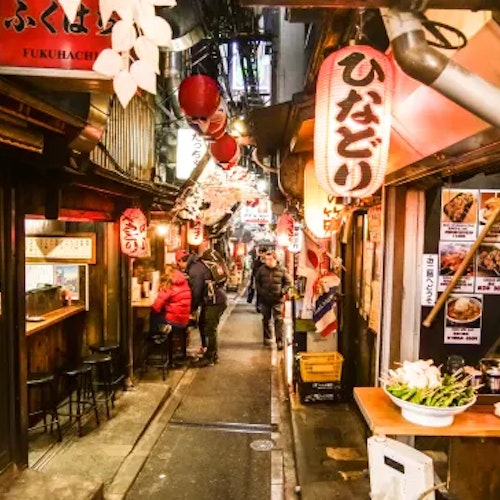

The Japanese Grand Prix at Suzuka Circuit is one of Formula 1's most legendary races, combining world-class motorsport with passionate fans and Japan's incredible culture.
If you're planning to attend the 2026 event, this comprehensive guide covers everything you need to know about dates, tickets, seating options, and insider tips for an unforgettable experience.
The 2026 Japanese Grand Prix will take place from March 27-29, 2026 (Friday through Sunday) at Suzuka Circuit. The weekend actually begins on Thursday, March 26, with paddock access and special events for premium ticket holders.
The typical race weekend schedule includes:
Thursday, March 26: Team arrivals, paddock setup, VIP experiences
Friday, March 27: Free Practice 1 and 2 (with "Free Friday" seating policy)
Saturday, March 28: Free Practice 3 and Qualifying
Sunday, March 29: Race day
Insider Tip: Friday at the Japanese Grand Prix features the "Free Friday" policy, meaning you can watch from any grandstand except V1 and V2, regardless of which ticket you purchased. This is perfect for scouting your favorite viewing spots before race day.

The Japanese Grand Prix offers three main ticket types: General Admission tickets for open viewing areas without reserved seating (the most affordable option), Grandstand tickets with reserved seats offering comfortable seating and excellent views (mid-range pricing), and VIP tickets providing luxury hospitality with the best circuit views.
Price Ranges:
General Admission: Starting around $120 USD for single-day access
Grandstand seats: Between $400-$800 USD for Sunday race day
Premium packages: Starting from approximately $7,299 per person for complete travel packages
For those seeking luxury experiences:
Champions Club: Features covered seating with an outdoor balcony above the F1 team garages, world-class hospitality, canapés, light bites, curated lunch dishes, and an open bar with sparkling wine, beer, wine, and soft drinks
Paddock Club: The ultimate F1 experience includes Paddock Club hospitality, pit lane walks, guided paddock access, appearances by F1 media personalities or drivers, and podium ceremony access

Grandstands V1 and V2 line the starting grid on the main straight, with V2's upper rows stretching high above the track, providing a great vantage point to peer into the pit lane. V2 offers the best panoramic views at Suzuka Circuit, with higher seats in Zones 10-12 enabling glimpses of distant corners, including the final one, plus the main straight and grid.
Best for: Race start atmosphere, pit stops, podium celebrations, overall track overview
Features:
Big screen: Yes, Covered: Upper rows of V2 only, Numbered seating: Yes
Located directly opposite the pits with access to the Fan Zone
Grandstands A1 and A2 provide excellent views of cars entering the first corner, which has been the scene of many dramatic moments, including Kimi Räikkönen's famous last-lap overtake on Giancarlo Fisichella in 2005.
Best for: First lap drama, overtaking opportunities, race start excitement
Grandstand D offers fantastic views as cars navigate the famous S-curves where maximum concentration is required to nail the apexes, including the final corner of the complex, the Dunlop Curve.
Best for: Technical driving, witnessing driver skill, iconic F1 corners

Located at the final chicane, these grandstands sit at a section where drama always unfolds at Suzuka, famously the site of Senna and Prost's legendary title-deciding crash in 1989.
Best for: Overtaking action, low-speed technical section, late-race battles
Grandstand P is positioned along the outside of the exit of the legendary 130R corner, where cars reach their maximum speed before slowing for the chicane.
Best for: Maximum speed viewing, photography opportunities, experiencing raw F1 power
General admission areas at Suzuka may be some of the best GA sections for fans out of all F1 circuits, broken down into sections J, L, M, N, O, and P around the circuit, offering views of the renowned 130R bend and the Spoon Curve. Fans are allowed to bring foldable chairs or seat cushions, which makes the experience more enjoyable.
Best for: Budget travelers, flexibility to explore different viewpoints, authentic fan atmosphere

Unlock seamless connectivity across Japan with our tailored WiFi plans. Pick up at Narita Airport's Terminal 1 and stay effortlessly connected from 5 to 30 days.
Most international flights land at Tokyo's Narita airport (NRT) or Osaka's Kansai airport (KIX), with direct flights from LA to Tokyo or Osaka taking around 12 hours.
From major European hubs including London, Paris, and Frankfurt, direct flights to Tokyo and Osaka take around 11 hours, while from Australia, flight time varies between 8-11 hours.
From Tokyo, there are domestic flights to Nagoya's Chubu airport (NGO), or you can take the high-speed Shinkansen trains. Tokyo and Nagoya are connected by the JR Tokaido Shinkansen with travel times of 100 minutes on Nozomi trains, 110 minutes on Hikari trains, and 3 hours on Kodama trains, with single-trip costs from approximately $85 USD.
The 60km distance from Nagoya to Suzuka can be covered by train in around 1-2 hours, including wait times, with trains being the preferred mode of transport due to Japan's efficient rail network.
Recommended Route: Take the Kintetsu Limited Express from Nagoya Station to Shiroko Station (approximately 40 minutes), which has the most convenient connections to Suzuka.
Money-Saving Tip: Kintetsu provides a "Weekend Free Pass" at 4,900 JPY valid for 5 days, including weekends, perfectly covering travel from Nagoya to Suzuka (Shiroko Station), but you must buy this ticket at Kintetsu Station or an agent 1 day in advance.
Express buses operate from Nagoya Station, Osaka Station, Kyoto Station and regional stations directly to Suzuka Circuit from Friday to Sunday, with a return ticket typically costing 1,449 yen (approximately $7-10 USD) and taking around 15 minutes from the station to the circuit.

Nagoya is the closest large city to Suzuka at around 70km from the circuit, with the train trip taking 60-90 minutes and costing less than $10 USD each way.
Suzuka is a relatively small city with limited accommodation fully booked by teams and media, so Nagoya is the closest choice where accommodation is available at regular rates.
Recommended Hotels Near Nagoya Station:
Meitetsu Grand Hotel (Mid-range, 2-minute walk to station)
Nagoya Marriott Associa Hotel (Luxury option)
Hotel Livemax Nagoya Shinkansenguchi (Budget-friendly, 5-minute walk)
Osaka is further from Suzuka than Nagoya but offers a larger city with more to see and do, particularly its famous food culture, with the distance of 130km to Suzuka taking around 2-2.5 hours by train.
Stay near: Osaka Namba station is recommended if possible, as Osaka Tennoji and Shin-Osaka require transfers to get to Suzuka.
Staying near the track in Suzuka is difficult for most fans as hotels are snapped up by F1 teams and limited options are expensive and isolated, so booking well in advance is key.

The Ferris Wheel at Suzuka is free for all ticket holders and offers 360-degree views of the entire track, with two lines available: driver-decorated cars (longer wait) and non-decorated cars (faster line). Friday is the best day to ride with shorter lines.
Three grandstands at Suzuka offer seats for wheelchair users and people with reduced mobility: V1, V2 (covered by a roof), and B1 (covered by a roof).
At the end of March, expect mild and pleasant weather with average temperatures seeing highs of 17°C (63°F) to lows of 8°C (46°F), though spring showers are possible.
What to Pack: Rain gear, sun protection, comfortable walking shoes, seat cushion (for GA areas), foldable chair (allowed in GA)
Queues for food stalls get very long, so either bring your own bento or time hunger cravings for off-peak dining. The circuit welcomes millions of fans, requiring long queues for everything, including food stands, so bringing food is advisable.
Japanese F1 fans are enthusiastic, supremely knowledgeable, and famously quirky in expressing their love for F1, with rear wing hats featuring working DRS and creative costumes being common sights. The atmosphere is electric with passionate yet respectful fans from both Japan and around the world.

Suzuka Circuit is one of the most iconic tracks in motorsport with its unique figure-eight layout, 5.807km length, and 18 turns, including famous sections like the S-Curves, Degner Curves, Spoon Curve, 130R, and the final chicane.
Opened in 1962, Suzuka is one of the few tracks in the world to feature a crossover where the track passes over itself, with its mix of high-speed straights, technical corners, and elevation changes making it a favorite among drivers and fans.
The circuit has hosted legendary F1 moments including:
The intense Senna and Prost rivalry championship deciders in 1989 and 1990
Sebastian Vettel's perfect "Grand Slam" in 2012 with pole position, fastest lap, race win, and leading every lap
Max Verstappen securing his second consecutive World Championship in 2022 under challenging wet conditions
The late March timing of the 2026 race coincides with Japan's cherry blossom season, offering a spectacular cultural experience. Visiting the Japanese Grand Prix provides a unique opportunity to explore one of the world's most visited countries, with Japan sitting at the top of most people's bucket lists.
Beyond the Race: Explore Tokyo's bustling streets, historic Kyoto temples, Osaka's incredible food scene, and Japan's natural beauty. The high-speed Shinkansen trains make traveling between cities convenient and efficient.

Experience the beauty and culture of Tokyo's cherry blossom season with our expert-guided tour.
Book Early: Tickets and accommodation sell out months in advance
Choose Nagoya: Most convenient base for track access and accommodation availability
Consider V2 Grandstand: Best overall value for first-timers wanting comprehensive views
Explore on Friday: Take advantage of Free Friday to scout different grandstands
Plan Transport: Purchase a Kintetsu Weekend Pass in advance for unlimited train travel
Embrace the Culture: The Japanese Grand Prix offers much more than racing
The 2026 Japanese Grand Prix promises to be an extraordinary event combining world-class motorsport, passionate fans, and unforgettable Japanese culture. With proper planning using this guide, you'll be set for the F1 experience of a lifetime at the legendary Suzuka Circuit.



